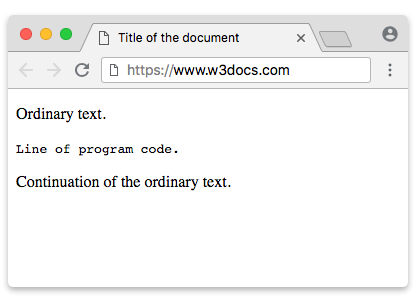The <code> tag is used to insert variables, fragments of program code, etc. into an HTML document. In the browser, the code is displayed in a monospaced font (a font in which all characters have the same width) of the smaller size.
The <code> tag alone represents a single code line or code phrase. It should be wrapped within a <pre> element for representing several lines of code.
You can use CSS to achieve better effects.
Syntax
The <code> tag comes in pairs. The content is written between the opening (<code>) and closing (</code>) tags.
Example of the HTML <code> tag:
<!DOCTYPE html>
<html>
<head>
<title>Title of the document</title>
</head>
<body>
<p>Ordinary text.</p>
<code>Line of program code.</code>
<p>Continuation of the ordinary text.</p>
</body>
</html>Result

Example of the HTML <code> tag placed inside an HTML <pre> tag:
<!DOCTYPE html>
<html>
<head>
<title>Title of the document</title>
</head>
<body>
<pre>
<code>
body {
color: yellow;
font-size: 16px;
line-height: 1.5;
}
</code>
</pre>
</body>
</html>Example of the HTML <code> tag with CSS properties:
<!DOCTYPE html>
<html>
<head>
<title>Title of the document</title>
<style>
.code-style {
font-size: 20px;
line-height: 28px;
background-color: lightblue;
color: #ffffff;
}
</style>
</head>
<body>
<p>Ordinary text.</p>
<code class="code-style">Line of program code.</code>
<p>Continuation of the ordinary text.</p>
</body>
</html>Attributes
The <code> tag supports the Global Attributes and the Event Attributes.
How to style <code> tag?
Common properties to alter the visual weight/emphasis/size of text in <code> tag:
- CSS font-style property sets the style of the font. normal | italic | oblique | initial | inherit.
- CSS font-family property specifies a prioritized list of one or more font family names and/or generic family names for the selected element.
- CSS font-size property sets the size of the font.
- CSS font-weight property defines whether the font should be bold or thick.
- CSS text-transform property controls text case and capitalization.
- CSS text-decoration property specifies the decoration added to text, and is a shorthand property for text-decoration-line, text-decoration-color, text-decoration-style.
Coloring text in <code> tag:
- CSS color property describes the color of the text content and text decorations.
- CSS background-color property sets the background color of an element.
Text layout styles for <code> tag:
- CSS text-indent property specifies the indentation of the first line in a text block.
- CSS text-overflow property specifies how overflowed content that is not displayed should be signalled to the user.
- CSS white-space property specifies how white-space inside an element is handled.
- CSS word-break property specifies where the lines should be broken.
Other properties worth looking at for <code> tag:
- CSS text-shadow property adds shadow to text.
- CSS text-align-last property sets the alignment of the last line of the text.
- CSS line-height property specifies the height of a line.
- CSS letter-spacing property defines the spaces between letters/characters in a text.
- CSS word-spacing property sets the spacing between words.
Browser support
|
|
|
|
|
|
|---|---|---|---|---|
| ✓ | ✓ | ✓ | ✓ | ✓ |
Practice Your Knowledge
Quiz Time: Test Your Skills!
Ready to challenge what you've learned? Dive into our interactive quizzes for a deeper understanding and a fun way to reinforce your knowledge.